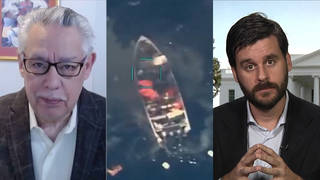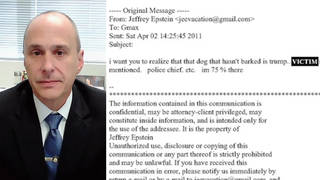
Topics
Guests
- Patty LoveraAssistant Director of Food & Water Watch.
- Dr. David WallingaDirector of food and health at the Institute for Agriculture and Trade Policy. Dr. Wallinga is co-author of the new studies on mercury levels in products with high-fructose corn syrup.
We look at two stories on food safety. The FDA has
issued one of the largest food recalls in history after eight people died of salmonella poisoning. A Georgia peanut plant knowingly shipped products contaminated with salmonella on a dozen occasions over the past two years. And a pair of new studies has revealed traces of toxic mercury can be found in many popular food items containing high-fructose corn syrup. The sweetener has become a widely used substitute for sugar in processed foods, including many items marketed toward children. [includes rush transcript]
Transcript
AMY GOODMAN:
Federal officials revealed a Georgia peanut plant knowingly shipped products contaminated with salmonella on a dozen occasions over the past two years. On Wednesday, the FDA expanded its recall of peanut butter products in what’s become one of the largest food recalls in US history. The FDA is now asking retailers, manufacturers, consumers, to throw out every item containing peanut products manufactured at the Peanut Corporation of America plant in Blakely, Georgia.
Salmonella poisoning has already killed at least eight people, sickened more than 500, half of them children. More than 400 consumer products containing peanut butter have been pulled from the shelves, including Clif bars, ShopRite peanut butter crackers, Famous Amos cookies and King Nut peanut butter. Peanut Corporation of America sells peanut products to institutions like schools, nursing homes, and to other companies, including Kellogg’s, which turns the butter or paste into other products.
The peanut scare raises new questions about the FDA’s regulatory practices. The Washington Post reports, prior to the salmonella outbreak, the FDA hadn’t inspected the Georgia plant since 2001. In 2006, the agency contracted inspections to the Georgia Department of Agriculture, but last year state officials failed to check for salmonella.
Meanwhile, another story involving food safety has just come to light. A pair of new studies has revealed traces of toxic mercury can be found in many popular foods containing high-fructose corn syrup. The sweetener has become a widely used substitute for sugar in processed foods, including many items marketed to children. Items found to contain mercury include Hershey’s chocolate syrup, Smucker’s strawberry jelly, Hunt’s tomato ketchup, Coca-Cola Classic, Quaker Oatmeal to Go, Nutri-Grain strawberry cereal bars. Mercury is considered toxic in all forms, particularly dangerous for children.
We’re joined now by two guests. Patty Lovera joins us from Washington. Assistant director of Food & Water Watch, she’s been closely monitoring the peanut butter recall. Dr. David Wallinga has joined us from Minneapolis. He’s the director of food and health of the Institute for Agriculture and Trade Policy. Dr. Wallinga is co-author of the new studies on mercury levels in high-fructose corn syrup food products.
I want to start with Patty Lovera in Washington. Talk about the magnitude of the peanut problem.
PATTY LOVERA:
Well, this — we’ve been struggling to get information from FDA and from this company about the magnitude, but what it shows is that there was really no presence of regulators in this plant for a very long time, and they’re clearly a massive supplier to food service, to the processed food industry, and it’s a really ubiquitous ingredient. So it’s going to keep getting bigger for a while, as they really kind of grapple with what was going on in this plant and the reach of this company. It seems like an enormous amount of product was coming out of this plant every day, and it really — they weren’t doing what they were supposed to do in terms of safety.
AMY GOODMAN:
So, is it whole peanuts, Patty? Or is it once — does the salmonella contaminate when it’s crushed, when it becomes paste or peanut butter?
PATTY LOVERA:
That’s one of the things we were hoping they would know by now, so there’s a lot of questions. You know, were the raw peanuts coming into the plant with salmonella? But, you know, they roast them, and they do things to them that should take care of it. Were they not doing those steps? Or was the plant dirty and it got — you know, the product got re-contaminated. This is all of the stuff that this investigation should tell us. It hasn’t yet. But it does seem like they’ve done sampling in the plant, and they’ve found salmonella in the plant. So it seems like there’s sanitation problems, as well.
So the products that are involved are everything in this plant. So that’s whole peanuts that were used as an ingredient and then various types of processed peanuts, like peanut butter or peanut paste they would use to thicken something. So it’s really a wide array of products that go out then into the food chain through these other processed foods.
AMY GOODMAN:
Patty Lovera, then explain what salmonella is and then what it does when ingested.
PATTY LOVERA:
So, salmonella is a pathogen. It is found in many forms. There’s different strains, and that’s one of the issues with this investigation, is which strain was found in which product and in the plant. And it’s often associated with animal production, and so there’s — that’s a logical question. You know, what do we know about the fields where these peanuts were grown? You know, were they being treated with animal waste? From what kind of facility? We don’t know any of that yet.
And then also, salmonella can be found in the environment. And so, in previous peanut butter problems, they’ve found salmonella coming in through leaking roofs and things like that. And so, it’s really very present in the environment, but it’s also considered an indication of how the sanitation of a plant is, how clean is it, how often are they keeping — are they doing cleanings? Are they keeping products, you know, raw products separated from finished product? So it’s really a good indicator of the processes in this plant, and clearly these processes weren’t up to speed.
And so, when people are exposed to salmonella, it’s really a digestive system issue. People get diarrhea. They get very sick. And people that are vulnerable to diseases, like young children or older people or people with immune system problems, are most at risk.
AMY GOODMAN:
David Wallinga, you’re the director of food and health at the Institute for Agriculture and Trade Policy in Minneapolis. Talk about this second part of a major health threat right now in this country. High-fructose corn syrup, in itself, has problems when we’re talking about issues like obesity, of course. Tell us what you’ve found.
DR. DAVID WALLINGA:
Well, let me just lay a little context first for the two studies that came out. Really at the core of it is that there are large chemical plants, chlorine alkali plants worldwide, that make a variety of chemicals, and many of them are used commonly in food production, including in the production of high-fructose corn syrup and some other things.
And the first study, which came out Monday, was a scientific study. It was in a peer-reviewed journal. And it talked about high-fructose corn syrup samples that were collected when the lead author was at the FDA as a public servant and then tested for total mercury. And lo and behold, what they find was about half of the twenty samples that were collected of the high-fructose corn syrup had detectable mercury at varying levels.
And then the second study was one that my own group did that tried to extend on this problem and finding and go out to supermarkets and actually look for common brand-name food and beverage products and test them for total mercury, as well. And we found that about one-in-three of the fifty-five products that we sampled had detectable mercury in them.
AMY GOODMAN:
How does it happen? How does the mercury contaminate the corn syrup?
DR. DAVID WALLINGA:
Well, how it happens is like this. These huge chlorine plants, many of them continue to use a really outdated technology that’s based on mercury cells. It’s not the only technology they could use. It’s only one of three, but many still use it, despite the fact that we’ve known for a long time that they are big polluters of mercury into the environment.
What was kind of an open secret in the industry, though, was that the food-grade chemicals that came out of these plants could also be contaminated with mercury. And so, what these new studies shed the light on is the possibility that we’re getting significant exposure to mercury through these contaminated food chemicals.
AMY GOODMAN:
What is the FDA doing about this?
DR. DAVID WALLINGA:
Well, unfortunately, you know, like the previous speaker said, the FDA’s problems kind of speak for themselves. Their response this week was basically, “We’re dealing with salmonella. We don’t have time to worry about high-fructose corn syrup.”
I think it reflects a bigger problem, though, in that not only is the FDA kind of asleep at the switch, but they’ve probably been underinvested. In other words, society has just decided that public health investments to protect the food supply or to look for salmonella are not a good investment, and so we’re suffering the consequences now, I think, from that lack of oversight and investment.
AMY GOODMAN:
And the use of high-fructose corn syrup — I mean, a lot of people might say, “What are you talking about? Sugar, right?”
DR. DAVID WALLINGA:
Well, high-fructose corn syrup is a sweetener, just like sugar or honey and molasses are sweeteners. And what’s different is that high-fructose corn syrup’s really only been widely used in the US food industry since maybe the mid-’70s and only used in soda pop since the early ’80s, but it’s rapidly become the major sweetener, to the point where now one-in-ten calories that the average American eats comes from high-fructose corn syrup, and that’s the USDA’s own figures.
AMY GOODMAN:
And the politics of corn and how it’s come to replace sugar?
DR. DAVID WALLINGA:
Well, I think it’s politics and economics. As everyone knows, or should know by now, as a country, we produce a heck of a lot of corn. And that, in and of itself, isn’t a bad thing, but some of our policies have made corn extremely inexpensive for people to make all sorts of things out of it, including sweeteners, but as well fuels and other things.
So high-fructose corn syrup as a sweetener has been a pretty cheap staple for the food industry, and they’ve found — they’ve been very imaginative in finding lots of different food products to put it in, you know, everything from fast foods, where it’s pretty ubiquitous, to salad dressings to barbeque sauce, as well as soda pop, of course.
AMY GOODMAN:
Has the embargo against Cuba helped with keeping the corn syrup prices low and sugar prices high? I assume that the high-fructose corn syrup lobby has been a great supporter of the embargo.
DR. DAVID WALLINGA:
Well, you’re getting a little far afield from what I’m looking at in these studies, so I don’t know about that. But I think the issue here isn’t just about high-fructose corn syrup, but, you know, the bigger point to the story, I think, is that we have an alternative way of making these products. The caustic soda, for example, is integral to the production of high-fructose corn syrup. You can make caustic soda using mercury, or you can make it without using mercury. Unfortunately, we still have plants in the US, and even more abroad, that continue to use this outdated mercury technology that can contaminate the caustic soda with mercury. And that’s what, in turn, we think, may be contaminating the high-fructose corn syrup. So, then-Senator Obama actually was a co-sponsor of Senate legislation in 2007 that would have phased out the use of mercury in making caustic soda in these plants, but the legislation never passed. We think it would be a —
AMY GOODMAN:
The Corn Refiners Association has rejected the mercury study. Audrae Erickson of the Corn Refiners Association said in a statement, quote, “This study appears to be based on outdated information of dubious significance. Our industry has used mercury-free versions of the two re-agents mentioned in the study, hydrochloric acid and caustic soda, for several years. […] It is important that Americans are provided accurate, science-based information. They should know that high fructose corn syrup is safe. In 1983, the U.S. Food and Drug Administration formally listed high fructose corn syrup as safe for use in food and reaffirmed that decision in 1996.”
DR. DAVID WALLINGA:
Yeah, well, I think there’s two important points from that statement. The first is, the data that came out this week is the only public data available. So, neither the FDA nor the Corn Refiners Association has come forward with any data. The scientific study collected high-fructose corn syrup samples in 2005 and tested them, so that’s the only data we have to go on. Our report dealt with supermarket foods that were collected this fall in the Twin Cities. So that’s pretty up-to-date, I think.
AMY GOODMAN:
Let me play for you the Corn Refiners Association ad. They launched a marketing campaign to defend high-fructose corn syrup. The lobbying group ran several television ads promoting the sweetener to be a natural product, just like regular sugar.
TEENAGER 1: Once again, you’re demonstrating an inferior intellect.
TEENAGER 2: That cereal has high-fructose corn syrup in it.
TEENAGER 1: So?
TEENAGER 2: So even a dufus like you must have heard what they say about it.
TEENAGER 1: What?
TEENAGER 2: Well, dude, I mean, you know, I mean…
TEENAGER 1: That it’s made from corn? And it’s nutritionally the same as sugar? And it’s just fine in moderation?
TEENAGER 2: Whatever, dude.
TEENAGER 1: Did Mom and Dad teach you any manners?
NARRATOR: Get the facts. You’re in for a sweet surprise.
AMY GOODMAN:
Your response, Dr. David Wallinga?
DR. DAVID WALLINGA:
Well, you know, I don’t think our research says something either way about the healthfulness of high-fructose corn syrup, per se. I think what it points to is that there’s different ways to make it, and we think we ought to be making high-fructose corn syrup without chemicals that can be mercury-contaminated. And we have the technology to do that. I think the industry just needs kind of a good solid push in that direction, and Senator Obama’s legislation and that sponsored by others would do that.
AMY GOODMAN:
What are the dangers of mercury, especially when it comes to kids?
DR. DAVID WALLINGA:
Well, mercury, in general, comes in a lot of different forms, and all the forms are basically toxic to varying degrees. We know the most about a particular form called methylmercury, and people will recognize that because it’s the one in fish and seafood. And all the federal standards are based on methylmercury. We don’t really know what kind of mercury is in high-fructose corn syrup. I would hope that if FDA does further testing — and I hope they do — that that’s one of the questions they would answer, is — what’s the mixture of mercury in the high-fructose corn syrup that we’re finding?
But even beyond that — you know, because you could spend years having debates over that, I think, is this point that there are different ways to make high-fructose corn syrup. We could easily transition the industry to only making high-fructose corn syrup and other food products using chemicals that aren’t mercury-contaminated because of these plants that use this outdated technology. That’s where I think we need to go.
AMY GOODMAN:
And finally, back on the issue of the peanuts, I want to ask Patty Lovera if she agrees with senior congressional and state officials, like Congress member Rosa DeLauro of Connecticut, calling for a federal probe of possible criminal violations at the Georgia peanut processing plant.
PATTY LOVERA:
Yes. Sadly, I mean, I think that’s what it’s come to. I mean, this is a plant —- I mean, everything that the FDA does is basically voluntary. They ask these plants to regulate themselves, and then they act surprised when it goes badly. But this plant did some testing, saw a problem -—
AMY GOODMAN:
Five seconds.
PATTY LOVERA:
— and just did more testing until it came up OK. And that should be investigated, and they should have some penalty for that.
AMY GOODMAN:
Patty Lovera of Food & Water Watch and David Wallinga of Institute for Agriculture and Trade Policy, thanks so much for joining us.












Media Options